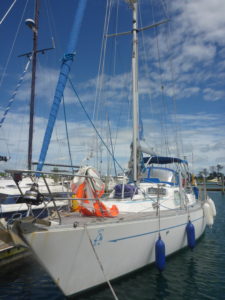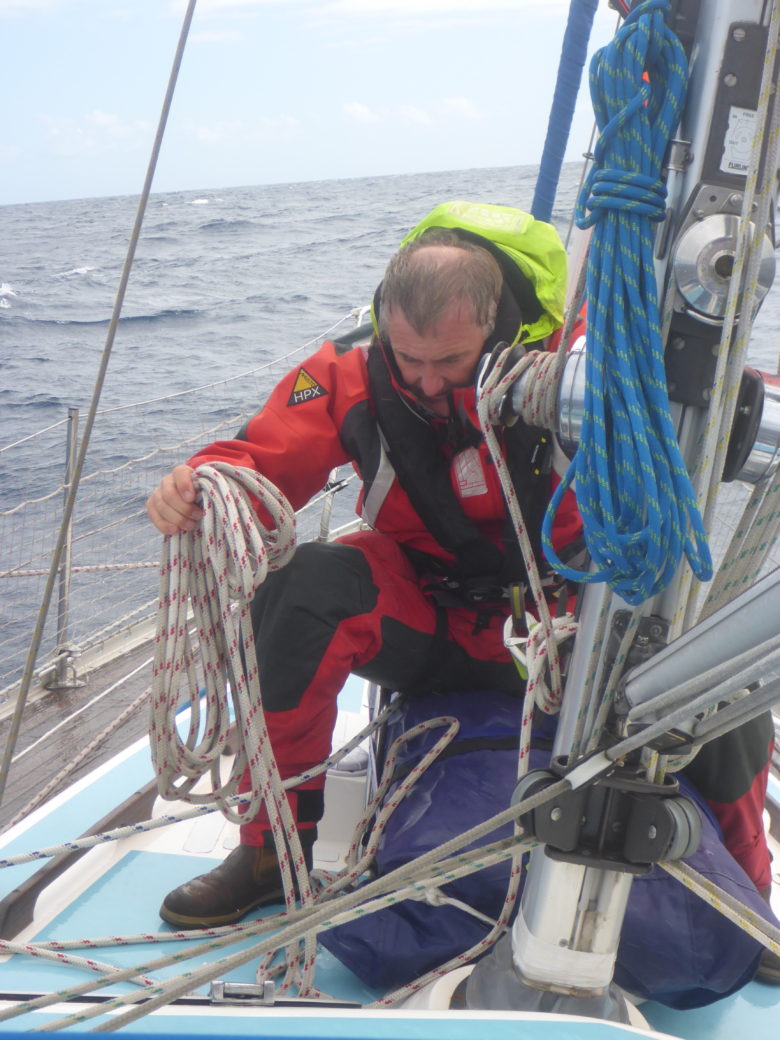23:39.49S 178:54.132W North Minerva Reef
It took five days of fitful, sometimes perfect sailing and a worrying 40 hours of motoring to reach the surreal North Minerva Reef. We had to slow Zoonie so as to arrive in first light, at a time when speed is of the essence. We even toyed with the idea of sailing past, as others did, using what appeared to be a good weather window to continue the passage.
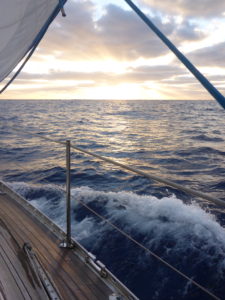
But we had been doing three hour watches at night instead of five hour ones and being woken up twice each night from deep sleep had taken its toll. And apart from that we needed to ready Zoonie for what may be ahead.
The first thing we saw of the reef were the familiar two masts of the catamaran which had left Tonga with us, safely anchored inside on the lagoon. Then random rocks could be seen sitting on the reef just like the surface of the moon. But unlike the moon, clouds of white water and rollers were breaking as we approached from half a mile away. Rob gave me a waypoint about a mile out so I had time to line Zoonie up for a transit in. The water was lighter to each side of the wide gap showing where the reef dropped away to deeper blue water in the middle. A nice straightforward entry and then 3.5 miles across to the comparatively rock free SE side where we would be facing the wind over the reef and so not likely to be pushed towards it.
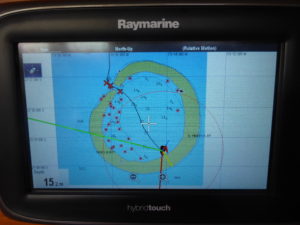
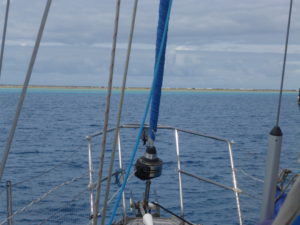
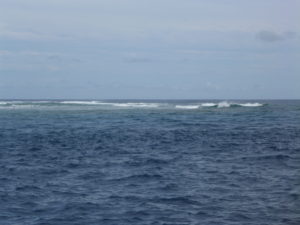
I imagine the navy of some country such as the US, Japan or Aussie or NZ have blasted these entrances into North and South Minerva because an entire fleet could rest up in here.
After anchoring Rob had a chat with the gentleman on the cat over the radio. They arrived the day before but would be setting off the next morning into the continuing good weather window. A slow moving high over us giving SE – E winds for the next few days.
We downloaded a grib file and agreed we would stay just the one night, do the necessary jobs and leave on the morrow. The storm jib was set on the new babystay on the foredeck. The deflated tender was double lashed to the foredeck, the ventilation dorades were replaced with screw on covers. Sails were moved from the forepeak to the main saloon to lighten Zoonie’s bow and, bizarrely our walking shoes were cleaned of their Machu Picchu mud ready to comply with NZ Biosecurity!
We relaxed in the cockpit with a second rum punch and lime juice watching the mirage on the opposite side of the reef. Rocks and clouds of foaming water were not attached to anything, instead they floated like irregular genies, the air beneath them undulating like mesmeric heat vapour. A few white sails sped by and three more yachts came in for a brief respite. No derelict yachts here!
There was no moon on the night of the 27th October, just bright stars twinkling and a few clouds making their way north west. A few lonely yachts passed by, their red port side navigation lights eyeing the peaceful lagoon where the four of us lay at anchor. Did they wish they had come in for a rest or feel that would be a waste of time. Who knows. The roar of the breaking surf continued all night and we woke early to see the reef covered as the tide was high.
The tropics were behind us now and the saloon thermometer struggled to reach 20’Celcius. We had 573 miles to go to the end of this second leg, a point at which we had to decide whether to continue straight away if a high pressure system was settling over Northland NZ. If there was a low moving across we would wait until it had passed and we could see no secondaries developing. These lows emerge cold and angry from the southern ocean and Antarctic waters and speed up the Tasman Sea with only destruction on their minds. Were our nerves a little wracked? Well maybe just a little.
It took 40 minutes to retrieve the anchor (last used in Bora Bora), pulling lengths of chain in using a line from the chain, back to the main winch in the cockpit to pull it in, then locking it off with a strop on the foredeck so the line could be brought forward and attached to the chain just arrived on deck once more. You know the form by now?
Zoonie had no such thoughts about what lay ahead and delighted in having both sails out and creaming along at 7 + knots over the Fiji Basin.
I was standing at the chart table noting the Lat and Long when I realised the Long figure was reducing instead of increasing. We had crossed the 180 Greenwich Longitude on the opposite side of the earth and were now counting down to Greenwich. The dateline has a massive kink in it here to the east so that all of Tonga, Fiji and New Zealand are in the same time zone.
The gallant winds of the start did not last the first 24 hours and we had to do a little motor sailing the first night. 1200rpm gave us four knots and another knot and a half came from the sails.
But yesterday morning as the sun rose so did her night time shift of a strong wind from the same direction. A fingernail moon watched over the pair; it was busy in that part of the sky just then.
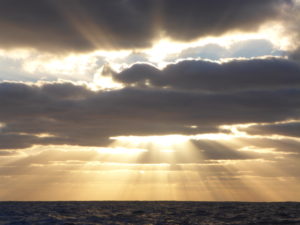
The wind has continued since and we are more and more confident we will have enough fuel to assist us between here and Whangarei.
I was slapped on the leg by a flying fish as it landed in the cockpit one night. With my head torch on I was able to help this little one, lifting him over the cockpit side and back into the scuppers where he flicked himself overboard leaving a path of sticky, smelly scales. But the one that flopped loudly across the sprayhood and landed on the side deck by the deck saloon was doomed, for he lay beyond our golden rule, neither of us leaves the cockpit at night while the other is asleep.
“And when we get to New Zealand darling, I’ll buy you a new pair of (black) leggings, your bum looks like the Milky Way!” (My white knickers showing through the holes in the seam).
So eloquent I thought. “No Rob, I can soon sew a new back seam!”
Porridge, pancakes and papaya were the order of the day today. Porridge because Rob was chilled from his 2 – 5 watch and the oats need using up. Pancakes so we can lavish them with the lime juice I squeezed yesterday, and again has to be used up. A gin and tonic comes to mind. Number three of Barry’s papayas is now ripe, so I fleshed it out and threw the skin and seeds overboard.
Potatoes and carrots were set to boil and then cool for a potato and egg salad lunch which will also use the last tomato and some sliced onion. Barry laughed when we presented him with a bottle of unopened mayo back in Hunga Haven, “Of course you’re not allowed to import it to NZ are you.”
28:15.76S 175:04.48E Early morning winding incident over the Cook Fracture Zone.
Not that the ocean floor layout had anything to do with it. Darkness prevailed when Rob woke me to help with some urgent reefing. He pulled in on the genoa reefing line as I let out the sail to give him some purchase. I then started winding the smaller genoa back in. Then as he came across the cockpit to lend me a hand he accidentally knocked the beaker of cold water out of the holder infront of the wheel and neatly down my back and on downward as gravity dictated.
“Sorry love”, he said and I was believing him until he laid a cold wet hand in the same area. It was the last night warm enough to be sleeping virtually naked after that not only were we wearing T-shirt and leggings but needed the blankets to be warm enough to drop off to sleep.
By the morning Zoonie was taking on 25 knot squalls so we altered course to go further west and delay meeting a low pressure front that was racing to the same spot as us.
We thought we would heave-to (set Zoonie so the foresail was sheeted to windward effectively stopping her so all she would do was drift harmlessly and gently no matter how strong the wind) to avoid arriving at the waypoint too early, so Rob hanked the storm sail onto the baby stay on the foredeck in readiness.
As it happened the winds were predictable, the barometer barely dropped two millibars and there was no significant increase in the sea state so we had a shallow Low and decided to use it. This was a low to be ridden on and not hidden from.
We spent the morning ferry gliding down the arm of the low pressure front while I baked lime drizzle cake and flapjacks. Got to use up the banned produce before NZ! Rob took some links out of his watch as it was too big for him either from loss of weight or the Tongan heat. I sewed up the back seam of my leggings so no more starry nights there!
The wind was due to back to the north west and then south west as the High Pressure system became established. But the weather down here can be as unpredictable as at home and the highs and lows change speed and direction. Also secondary intense little lows can develop off the back edge of a passing low and this is what happened next.
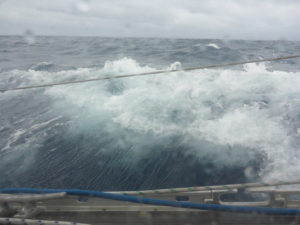
During that night the wind backed to the north-west so we jibed and progress was good until around 5.30am the next morning when the wind suddenly started to rise. Rob went forward to hoist the storm sail as the gusts were reaching 25+ knots. The barometer had dropped an alarming 11 millibars during the second half of the night.
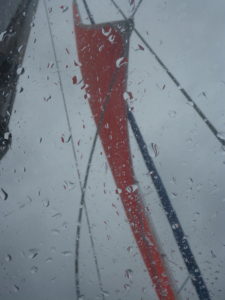
As I watched from the cockpit standing astride the seats clutching the sprayhood bar Rob hauled away on the halyard. I glanced at the starboard sheet, it had come out of the block and was flying free with no knot on the end. The sheets are new and very soft, the knot must have worked to the end of the sheet with the violence of the wind. Unbelievably quickly it was creating its own bizarre knot as it was flung around in the wind and I feared for Rob’s head if it should make contact. I yelled the predicament to him so he quickly lowered the sail again and tried to undo the knot.
It was so tight it appeared impossible to do, so he came back to the cockpit,
“We’ll have to use the genoa,”
“We can’t, it won’t heave to with the baby stay in the way, you have to undo it,” so back along the side deck he crawled, moving his lifeline forward as he went. Rob sat astride the foredeck as Zoonie pitched and rolled. He looked as he might have when aged two or three playing with building blocks on the living room carpet.
A few strenuous minutes on and the sheet was undone and re-fed through the block and into the cockpit, this time with a longer tail after the knot. We were glad to be protecting the genoa by furling it tightly home, too good a sail to risk in the winds that now exceeded 40 knots. The stormsail was up and pulling well but the motion was so uncomfortable we decided to heave to and all of a sudden Zoonie settled and the strain of her gear seemed so much lighter since she was not trying to make progress through the water.
Our track looked odd on the chartplotter. A definite kink, like a retrousse nose, a bent triangle showed where we met the secondary low. A line wiggling south showed our path as we tried to deal with it. Then a line back towards Tonga showed Zoonie being pushed gently sideways at a rate of 1.5 miles per hour for 7 hours. After that we started sailing again but the direction was west, since the wind was coming from our destination. At last, later that evening the wind veered west of south and we able to tack and sail a mere 40 degrees from our desired course.
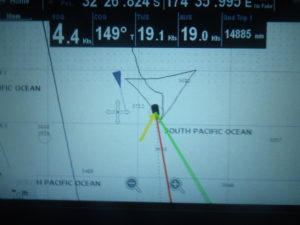
The wind continued to veer during the night and by morning Zoonie was speeding along on course. Rob and I sat below on the settee watching waves breaking right over her, it was like being in a carwash. I wished we could detach ourselves and fly around her like the seabirds or a drone, she must have looked fantastic ploughing through the not too rough seas with white veils of seawater flying her entire length. She made her own generous bow waves and wash but would be hit on both sides of her bow by waves that would create big thuds down below and vibrate every inch of her.
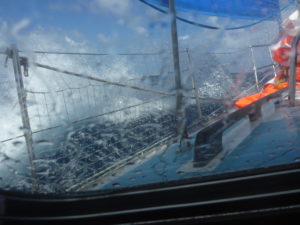
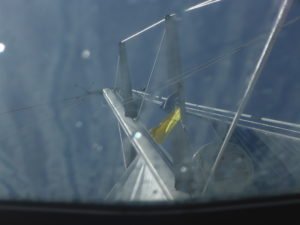
Later in the day we gratefully stowed the storm sail and re-set the genoa. In the gusts Zoonie will point up toward the wind and spill the excess so relieving the strain on the sails, a nice safe characteristic. The waves were smoothing off quickly as the wind eased and her progress was uninterrupted, like a racehorse on the final length before the finish of the race.
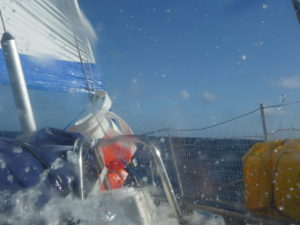
During the night the SSV Robert C Seamans called us as she felt her CPA, (closest point of approach) of 1 mile was too small. As she was rigged with numerous sails including a squaresail I think she would have liked us to alter course as we were more manoeuvrable, but in the end she eased her course a little.
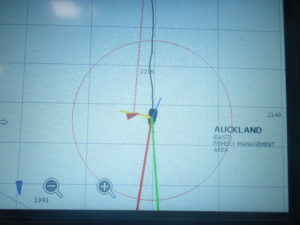
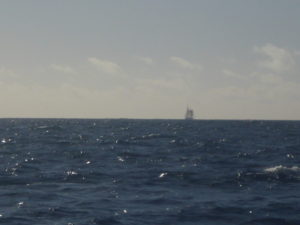
Then she called a large fishing vessel because his course was erratic, (he was fishing) and both the sailing ship and we needed to know his intentions. He motored between us on a parallel and opposite course to clear us before resuming his work.
The morning of 5th November brought our last day at sea. The sailing ship was making her way across our bow heading for Auckland when we spotted land, New Zealand, off to starboard. A Shy Albatross soared around us as if in greeting, its wingspan was well over two metres. Our ‘Seabirds of the World’ book told us it is the largest of the mollymawks and back 15 years there were 70,000 pairs around Auckland. Due to line fishing these birds are being decimated at a rate of over 10,000 per year. Their extinction appears inevitable.
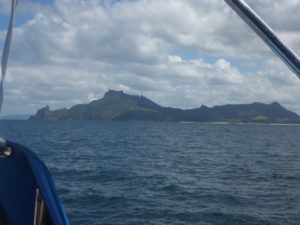
The day seemed to take ages longer than usual but gradually we made our way south past Motukawanui Island, Te Tarra Bay and on towards Bream Bay. It felt exciting, like Christmas Day.
Towards evening we were looking for the green and red fairway buoys into Whangarei Harbour. The wind was bang on the nose as we turned into the river estuary and made our way slowly toward the pile marking the entrance to the marina.
The Q quarantine berth ahead of us was empty and tying up was nice and easy for once. We had travelled 1464 miles in 14 days.
